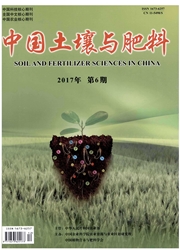

 中文摘要:
中文摘要:
为了缓解农业水资源紧缺的状况,通过小区灌溉试验,研究了不同水平的氮肥与不同灌溉量、不同灌溉次数的猪场废水配施条件下夏玉米主要生长指标的变化,探讨了水肥耦合对夏玉米产量和水分利用效率的影响,建立了夏玉米产量的水肥耦合模型,以期为制定合理的猪场废水灌溉制度提供理论依据。结果表明:相同施肥水平时,株高、叶面积指数表现为养殖废水高灌〉低灌〉对照处理,拔节期差异达到显著水平,收获后养殖废水高灌处理的产量和淀粉含量也显著高于低灌和对照处理。相同养殖废水灌溉条件下,不同施肥处理的株高、叶面积指数以及产量差异不显著。低灌处理水分利用效率要显著高于高灌处理;综合产量、水分利用效率等指标来看,猪场废水高灌(900 m3/hm2)、低水平施肥(30 kg/hm2)处理不仅节约肥料,而且能够保障产量。
 英文摘要:
英文摘要:
Water resource shortage and water pollution limit the sustainable development of rural areas. Piggery wastewater reuse can balance these two problems. In this paper, variation of growth indicators in summer maize was studied by the field experiment, which was with regard to different level of nitrogen fertilizer interaction with different irrigation quantity and frequency of piggery wastewater treated by anaerobic fermentation system. Meanwhile, coupling effect of water and fertilizer on the yield and water use efficiency of summer maize was researched, on basis of water and fertilizer data, the model of summer maize yield was built and validated in order to provide references for piggery wastewater irrigation schedule. The results indicated that : in the same fertilization conditions, plant height and leaf area index under the high irrigation treatments ( irrigation quota for 900 m3/hm2 ) were significantly higher than the low level treatments ( irrigation quota for 600 m3/ hm2 ), especially dur- ing the jointing stage. The yield and starch of high irrigation treatments were also significantly higher than low level treatments and CK, which showed that high irrigation treatments could significantly improve the growth index, while the result of water use efficiency was quite the reverse. In the same irrigation conditions, there were no significant differences among different level fertilizer on growth indicators and yield. Overall, Treatment ABD ( irrigation quota for 900 m3/hm2, amounts of fertilization for 30 kg/hm2) , taking into account all kinds of indexes, can not only economize on fertilizer, but also ensure the product output.
 同期刊论文项目
同期刊论文项目
 同项目期刊论文
同项目期刊论文
 期刊信息
期刊信息
